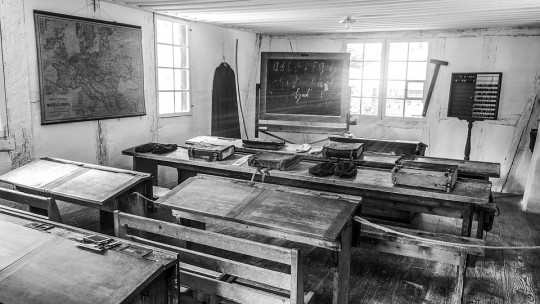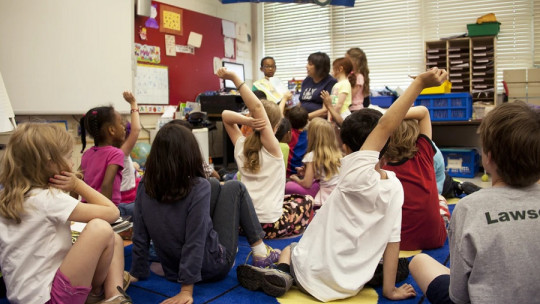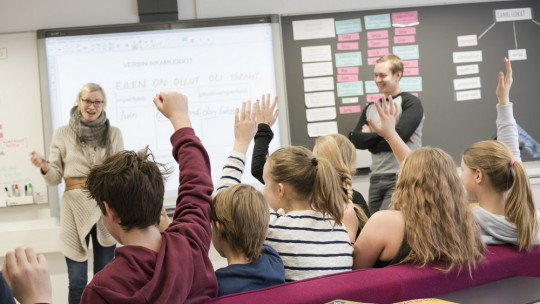You go to school to learn, but not all content is worthy of being taught by the formal educational system. Before the teacher or professor teaches his students something, that something must have been selected, being considered useful and necessary content for the educational audience to whom it is directed.
Curriculum theory is a pedagogical approach aimed at examining and shaping the contents that should be taught in the educational field , in charge of deciding what content should be part of an educational curriculum to ensure that students become individuals with useful skills in their daily and work lives. Let’s land on this concept and see where it comes from and what currents there are within this theory.
What is curricular theory?
Curriculum theory is an academic theoretical-practical approach aimed at examining and shaping the contents that should be taught in the educational field The followers of this current are responsible for deciding what content should be present in the academic curriculum, considering which are the most necessary, useful and appropriate learning for students within a specific educational system.
This approach can be done either by focusing on what a specific individual, a class, or all students who go through the educational system should learn.
Some of the fields to which this approach is dedicated are the analysis of the values that must be transmitted, the historical analysis of the educational curriculum, the analysis of current teachings and theories on the education of the future. Therefore, we can say that curricular theory is an approach related to several disciplines related to the pedagogical field, such as psychology, sociology, philosophy and, naturally, education.
The definition of the word resume
You cannot talk about curricular theory without defining what the curriculum is This, in fact, is one of the main aspects of the theory and, to this day, there is still some debate about what we can understand by curriculum or curriculum, since it is a polysemantic word, that is, with several definitions.
Although the word “curriculum” is a very close term for those who actively participate in educational processes from any field of formal education, its definition is even complicated for those who are professionals in this aspect. However, we can say that curriculum is a term used to refer to study plans, programs and even didactic implementations.
The five definitions that we can give about what a curriculum is are the following.
1. The curriculum as the contents of teaching
In this sense, curriculum is a list of subjects, subjects or topics that delimit that content that must be taught and learned in educational centers.
2. The curriculum as a plan or guide for school activity
The curriculum is a learning plan in which the need for an ideal model for school activity is emphasized Its function is to homogenize the teaching and learning process.
3. The curriculum understood as experience
In this case The curriculum is seen not as what must be done but in the reality that can be achieved Reality is the sum of the experiences of the students that have been achieved thanks to the school and its stakeholders.
4. The curriculum as a system
This conception of the curriculum draws from systems theory. A system is characterized by its constituent elements and the relationships established by these In this case, the curriculum would highlight the existence of educational goals that students must achieve.
5. The curriculum as a discipline
The curriculum is not only an active and dynamic process, but it is also a reflection on the same process
It is these five definitions that influence the conception of curricular theory and that today make it continue to be understood in multiple ways. However, the common aspects and main motivators of the development of such a theory is the purpose of make school content useful for students in addition to the intention of achieving homogenization of academic content but always taking into account the sociocultural phenomena from which students cannot separate themselves.
History of this theory
Curriculum theory has its origins in the first decades of the 20th century, with several people responsible for shaping this approach. This theory appeared shortly before 1920 in the United States at which time an attempt was made to homogenize school content in all schools in the country in response to the great wave of immigration from Europe and the great advances that were being made thanks to industrialization.
The United States at the beginning of the last century was experiencing an abysmal demographic increase, causing more and more people to require training to be able to function adequately in a society in which everything seemed to indicate that in the not too distant future technology was going to acquire a very important role. The idea behind the pioneers of curricular theory was to aim to provide a decent education to all citizens of the country equally.
It is John Franklin Bobbit who is credited with authoring the first work on curricular theory with his book “The curriculum” (1918). Bobbit was an educator, university professor and writer who belonged to the functionalist movement who gave two meanings to the word “curriculum.” On the one hand, it referred to the development of useful skills through a series of specific tasks, while on the other, it referred to the activities that should be implemented in schools in order to ensure that students acquire such skills.
Bobbit’s conception of the curriculum was that it was a description of the objectives that students should achieve during their time in the formal educational system. To do this, it was necessary to develop a series of standardized procedures so that all boys and girls in the United States had the same opportunities to obtain the same knowledge, wherever they lived. Added to this, the same tools should also be used when evaluating the progress made so that the students’ progress could be compared objectively.
Bobbit planted the seed for other thinkers to expand curriculum theory with their views and findings. Among them we have the figure of John Dewey, American philosopher, psychologist and educator who considered the figure of the teacher as a facilitator of learning for children. Dewey believed that the curriculum should be more practical, and serve to meet the future needs of boys and girls

Throughout the last century, followers of the functionalist current of education agreed that the educational curriculum should think above all about what children needed, but there was debate about what was the most appropriate way to implement this. Times changed and so did the content to be taught, which meant that the curriculum was somewhat unstable, a set of socially dependent knowledge that varied depending on the demands of society and what vision they had of what was “functional.” ”.
We have one of the modern works on curricular theory in the book “Curriculum: crisis, myth and perspectives”, by the doctor in philosophy and Mexican educational sciences Alicia de Alba Ceballos (1991). In this work, Dr. de Alba defends the curriculum as something that is nothing more than a set of values, knowledge and beliefs imposed by society and political reality in which it develops.
According to the Mexican doctor, the main objective of the different components of the educational curriculum is to impart a vision of the world to students through tools such as the imposition of ideas or the denial of other realities, something that has a certain indoctrinating nuance. .
No matter how much you try, Education is difficult to separate from politics and ideology since, in itself, the contents that must be taught are selected by people who consider what is appropriate and useful to teach, something modulated by their own way of seeing and understanding the world.
The main currents of curricular theory
Next we are going to see what are the most notable features of the main currents of curricular theory: academic, humanistic and sociological.
1. Academic stream
According to the academic current of curricular theory, the objective of education is specialize each student in a specific field of knowledge This conception supports the need for students to study increasingly complex and specific topics, giving them the option to choose those fields of knowledge that most attract their attention to carve out their desired future.
The curricular contents must be organized based on the specific competencies that each “expert” must acquire to do their job correctly. As this vision defends the idea of teaching useful knowledge to students within an industrial society, much emphasis is placed on science and technology, regardless of the interest that students have in the scientific-technological world.
The academic current sees the teacher as a person whose task is to provide his students with the necessary knowledge and help them resolve any doubts or problems they have. The educational effort does not fall solely on the teacher, since the students also have obligations the main one being to research the topics in which they want to specialize, be able to acquire new learning on their own and use what they learn in real life.
2. Humanistic current
In the humanistic conception The school curriculum is seen as a set of knowledge aimed at providing maximum satisfaction to each of the students The study should help people reach their maximum potential as individuals, in addition to making it easier for them to obtain emotional well-being. The school must be a place of personal growth and the content taught there must achieve this purpose.
But the responsibility for achieving this does not lie solely in the fact that the contents to be taught are carefully chosen. In addition to this, A cordial and safe climate must be created between students and the teacher the latter being the one who must act as a counselor instead of directly imparting knowledge as is the case in the other two branches of curricular theory.
In the curricular theory of humanistic conception It is argued that the knowledge taught at school should be flexible and different depending on the tastes and needs of each student By making students learn what really interests them and teaching them in a fun and motivating way, the educational experience is rewarding and useful in itself.
3. Sociological or functionalist current
Finally we have the sociological conception of curricular theory, also known as functionalist. This current understands studies as a way to prepare students for the world of work It has a vision of teaching as that process that must be responsible for preparing boys and girls to be able to fulfill a role that society requires of them.
This vision is in favor of imparting discipline, in addition to considering that it is appropriate to transmit the practical and theoretical knowledge that the youngest people will need to become good workers in the future.









